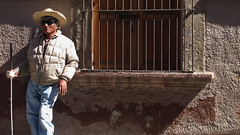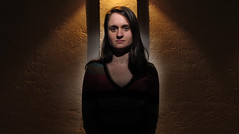 The Canon Powershot G11, the latest evolution of the G-cam line, represents a marked improvement over its predecessors -- which is really saying something.
The Canon Powershot G11, the latest evolution of the G-cam line, represents a marked improvement over its predecessors -- which is really saying something. It is a point-and-shoot that can take real photos, and quickly has become my near-constant companion. With its hot shoe and easily fudge-able sync speed, it is a great second body for those lighting photographers who also like to travel light.
__________
On the Street
As the Powershot G line has progressed, Canon has embraced knobs right alongside the menus and submenus. This makes for quick, intuitive operation for an old fart like myself.
It's a capable, multi-purpose still and video camera that doesn't make me feel like an idiot when I use it. And I would take it as my only body on a two-week vacation without a second thought.
The new, articulating viewfinder is surprisingly helpful when street shooting, too. Shooting from the hip -- literally -- is a breeze. Which is a good thing, because like the other Gs before it, the G11's optical viewfinder is pathetic and useless. I actually chose the G7 in part based on that feature and have used it, maybe, twice with the G-cams I have owned since.
The swiveling display screen also is fantastic for shooting video, and/or including yourself in the frame. It adds some thickness to the body, granted. But to my thinking, that also adds a little more stability at lower shutter speeds.
One Big Improvement
 The huge knock on the previous G camera was their low performance at high ISOs. The G11 has sacrificed the pixel count in favor of fewer, higher quality pixels. I found the higher ISOs to be much better than my previous G9, and did not miss the extra image size at all.
The huge knock on the previous G camera was their low performance at high ISOs. The G11 has sacrificed the pixel count in favor of fewer, higher quality pixels. I found the higher ISOs to be much better than my previous G9, and did not miss the extra image size at all.It's hard to quantify the difference grain and quality, so I will say it in the same way many others have. IMO, it gives you a one- to two-stop improvement in grain.
That is to say, performance at ISO 400 is better than was earlier performance at ISO 200. That seems to be the general consensus on the other reviewers, and I agree with them. For example, the cathedral interior above was shot at ISO 800. (Click on this or any pic in this post to get through to larger sizes if you want to pixel peep.)
Hopefully, the megapixel race is now dead, and camera manufacturers are starting to learn that we care more about quality than quantity. 'Bout damn time.
Kinda Flashy, Too
The hot shoe and manual control, of course, is why so many readers of this site go for the recent Canon G cameras, and the G11 works pretty much the same as the earlier ones did. Which is to say, it works great.
When the flash is turned on, the camera self-limits to 1/500th for synching. But when you turn the flash off the hot shoe is still live, and will technically sync away at any speed.
A few caveats:
First, sticking a recent Canon external flash on the hot shoe will trigger some TTL/etc. communication with the camera (it will run an STE-II trigger in TTL) and that will self-limit to 1/500th.
The trick is to fool the camera by synching in a dumb way -- on-camera (non-Canon) flash, hot shoe to PC adapter, non-Canon TTL cord, or a wireless remote.
Hardwire is best, as there is always some latency involved in a wireless remote that will rob you of a little marginal ultra-high sync speed. With a PW Plus II or a RadioPopper JrX, depending on your flash power setting your max useable synch will be between 1/500th and 1/1000th. The delays introduced by the electronics cost you some sync time.
With a PC cord (adapted with a Universal Translator) I got good synch on modest-power pops right up to 1/2000th. That makes for some daylight-killing speedlights. So if you want the most power out of your speedlight at the highest sync speed, go with a corded sync for one light and slave your others. SB-800s work great for this.
That will get you the most flash energy synched at the highest shutter speeds, by far. Using a corded main flash and a slaved secondary, I was able to get nearly all of the energy of a 1/8 power pop from the slaved flash at 1/2000th of a second. That includes the minor delays by the slave in the equation.
That test tells me that I could hard light, with multiple flash, at reasonable portrait distances at 1/2000th at f/8 at ISO 80. That would be underexposing full-sun ambient by over two stops.
Second caveat is to remember the laws of physics, in that it very much helps prevent your foolishly trying to break them. If a speedlight takes 1/1000th of a second to deliver the energy in a full-power pop, there is no way you are going to squeeze that into 1/2000th of a second shutter opening, ever.
Synch has nothing to do with it at this point -- the pulse is actually longer than your exposure. Rule of thumb: Assuming your camera does the cool overclocked sync thing, as you walk up the shutter speed scale you will be able to sync less powerful pops. It works progressively, until you finally get to a point where you can't synch anything due to various limitations.
 Working in manual mode with a single available continuous light wall sconce, this portrait of Beth (a student at San Miguel) was pretty quick and easy. We exposed in manual mode for the tungsten wall lamp, rendering the formerly white room black and orange-ish despite the midday window light.
Working in manual mode with a single available continuous light wall sconce, this portrait of Beth (a student at San Miguel) was pretty quick and easy. We exposed in manual mode for the tungsten wall lamp, rendering the formerly white room black and orange-ish despite the midday window light.Then a quick, homemade snoot made with black cinefoil kept the key light (a PW'd SB-800) restricted to Beth's face.
Because we moved Beth a couple of feet away from the wall, that left some room for the key light overspray to travel down behind her and hit the wall at about torso height. This made a neat little separation light that almost looks like a second flash working in the back.
With the Canon G11 and a single SB-800, this was a quick-and-easy lit portrait that could have been made out of a waist pack.
Anyone Else Out There?
Those are my thoughts on the G11, after a few weeks and many photos. If you are using one, I would love to hear your thoughts below, as would anyone else considering taking the plunge.
__________
:: Canon G11 ($450 - Amazon) ::




0 comments:
Post a Comment